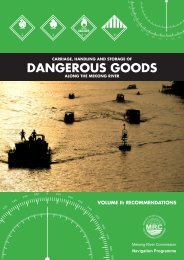evaluation of the study visit - Mekong River Commission
evaluation of the study visit - Mekong River Commission
evaluation of the study visit - Mekong River Commission
You also want an ePaper? Increase the reach of your titles
YUMPU automatically turns print PDFs into web optimized ePapers that Google loves.
MRC Study Visit to <strong>the</strong> Danube <strong>River</strong> Basin 2012<br />
<strong>the</strong> TNMN is to provide a structured and well-balanced overall view <strong>of</strong> pollution and long-term trends<br />
in water quality and pollution loads in <strong>the</strong> major rivers in <strong>the</strong> Danube <strong>River</strong> Basin.<br />
In response to <strong>the</strong> danger <strong>of</strong> flooding and in line with its Joint Action Programme, <strong>the</strong> ICPDR decided<br />
in 2000 to establish <strong>the</strong> long-term Action Programme for Sustainable Flood Prevention in <strong>the</strong> Danube<br />
<strong>River</strong> Basin. The whole process was accelerated after disastrous floods in 2002 and resulted in<br />
adoption <strong>of</strong> <strong>the</strong> Action Programme at <strong>the</strong> ICPDR Ministerial Meeting on 13 December 2004. The<br />
efforts <strong>of</strong> <strong>the</strong> ICPDR Contracting Parties focus on interlinking <strong>of</strong> <strong>the</strong> national and/or regional systems<br />
with <strong>the</strong> view <strong>of</strong> improving <strong>the</strong> overall coordination and transboundary coherence <strong>of</strong> flood<br />
monitoring and forecasting systems.<br />
VITUKI also operates <strong>the</strong> ICPDR’s Accident Emergency Warning System (AEWS), which is activated<br />
whenever <strong>the</strong>re is a risk <strong>of</strong> transboundary water pollution, or threshold danger levels <strong>of</strong> hazardous<br />
substances are exceeded. The AEWS sends out international warning messages to <strong>the</strong> downstream<br />
countries. This supports <strong>the</strong> authorities to put environmental protection and public safety measures<br />
into action. The system underwent a major test in 2000, during <strong>the</strong> Baia Mare and Baia Borsa spill<br />
accidents on <strong>the</strong> Tisa <strong>River</strong>. The system effectively enabled <strong>the</strong> timely activation <strong>of</strong> measures that<br />
prevented more extensive damage to people and ecosystems downstream along <strong>the</strong> Tisa <strong>River</strong>.<br />
Participants also had a chance to see <strong>the</strong> online flood warning tool operated by VITUKI.<br />
4.6.3 Addressed MRC Learning Points<br />
The discussions <strong>of</strong> <strong>the</strong> delegates <strong>of</strong> <strong>the</strong> Study Visit with <strong>the</strong> Austrian Ministry representatives focused<br />
on <strong>the</strong> link between national and international river basin management and <strong>the</strong> operation <strong>of</strong><br />
respective coordination mechanisms as well as <strong>the</strong> contribution <strong>of</strong> Hungary in <strong>the</strong> framework <strong>of</strong> <strong>the</strong><br />
ICPDR.<br />
In summary, <strong>the</strong> following MRC learning points have been addressed in detail and achieved:<br />
European Water Framework Directive (EU WFD)<br />
� National implementation <strong>of</strong> <strong>the</strong> EU WFD in Hungary from <strong>the</strong> regional to <strong>the</strong> national level;<br />
� Challenges on <strong>the</strong> basin-wide scale during <strong>the</strong> first WFD planning cycle;<br />
� Challenges <strong>of</strong> implementing <strong>the</strong> WFD in a transboundary sub-basin<br />
Preparation and implementation <strong>of</strong> <strong>the</strong> Danube <strong>River</strong> Basin Management Plan<br />
� Inter-linkage <strong>of</strong> <strong>the</strong> national <strong>River</strong> Basin Management Plans with <strong>the</strong> international Danube and<br />
Tisza <strong>River</strong> Basin Management Plan;<br />
� Implementation <strong>of</strong> <strong>the</strong> EU WFD and <strong>the</strong> respective development <strong>of</strong> <strong>the</strong> DRBM Plan seen from a<br />
contracting state’s perspective;<br />
� Contributions <strong>of</strong> Hungary to <strong>the</strong> development <strong>of</strong> <strong>the</strong> DRBM Plan;<br />
� Added values <strong>of</strong> an international DRBM Plan for <strong>the</strong> Hungarian national level;<br />
Development <strong>of</strong> basin-wide environmental objectives and baseline indicators<br />
� Presentation <strong>of</strong> environmental indictors, biological quality elements to assess baselines and <strong>the</strong><br />
water status classification system;<br />
� Current situation on water status as presented in <strong>the</strong> DRBM Plan;<br />
� Information on transnational water quality monitoring<br />
[17]













